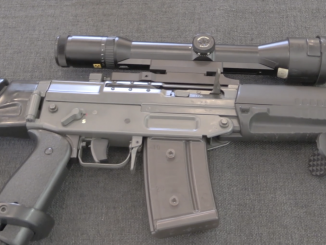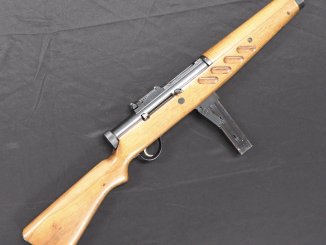The SIG 210, aka the P49, was a magnificent pistol, but really too expensive for a modern military sidearm. In the 1960s, the Swiss military began looking for a new service sidearm that would be a bit less costly, and SIG developed the 220 in response, which would ultimately be adopted as the P75. The P75 would maintain the basic structure of the P49, but used a folded sheet metal slide design and an alloy frame, significant departures from the all-milled construction of the P49. In today’s video, was have a fantastic set of P75 pistols to look at and see the whole developmental process. This includes two iterations of the first prototypes of the design, one of the very first production Army P75s, a standard late production P75 showing the final simplified features, and a Z-series border patrol example with its unique magazine release shield.




GM experimented with a a stamped slide on a 1911 variant. http://ww3.rediscov.com/spring/VFPCGI.exe?IDCFile=/spring/DETAILS.IDC,SPECIFIC=10024,DATABASE=26766896
Interestingly in 1930s HAFDASA made C-4 carbines which were like sub-machine gun, just without full-auto option:
http://www.guns.com/2014/03/07/hafdasa-carbines-odd-twist-argentina/
it uses aluminum casting in construction, HAFDASA stands for Hispano-Argentina Fábrica de Automóviles S.A. and as it imply it was manufacturer of automobiles, both Guide Lamp and HAFDASA employed manufacturing techniques used by them for production of fire-arms.
Historical antecedents for simplification of the Browning tilt lock: 1922 .45 Spanish pistol (Astra? Other?) seen on this channel, first cam-locked non-swinging-link barrel known to me. FN Browning P35, Browning himself chose and designed the cam as simplification starting in 1927 prototypes, not known if he knew about the earlier Spanish gun. French 1935S, first barrel locking into ejection port known to me, designed (by Petter? by unknown French engineers?) to simplify manufacturing by replacing the lug-and-rib lock of predecessor guns. I don’t know of any other manufacturer who did this until SIG or Sauer revived it, and now very few do not do this.
P210/P49 had both the swinging link and lug-and-rib locking; certainly part of its great expense.
The firing pin block was (if I remember correctly) patented by a Sauer engineer named Walter, and Wikipedia mentions several predecessors; SIG shouldn’t get all the credit for the design work here. Sauer also can claim first use of the hammer decock lever (from the 38H pistol, where the lever also cocked the hammer). Perhaps Sauer, the German firm, suggested the stamped-metal slide to the thrift-minded Swiss?
Speaking of the stamped-metal slide, also note that by final production the breechblock is held in the slide by a roll pin. I had read somewhere that US Army SIGs require replacement of this pin every 5,000 rounds fired. Not having a SIG-Sauer to examine, I don’t know how they now attach the rear sight. Made-in-America 220 series pistols are being manufactured with machined slides.
Note also this is the first Swiss service automatic to drop the feature of the slide resting inside the frame. Again, I can see this as a Sauer idea, successfully proving that the savings in cost would not alarmingly degrade accuracy.
Was absolutely fascinating to see how this firearm evolved and now works. Thank you!
“French 1935S, first barrel locking into ejection port known to me”
Earlier Webley & Scott automatic pistols also worked this way, according to http://revivaler.com/webley-automatic-pistols/
(…)barrel locked up into the ejection port just as the modern day Glock does(…)
Regarding the cam nose replacing the swinging link, the Polish Vis Model 1935 pistol was developed in the same timeframe as the FN GP, and its designers also decided on the cam nose system. The two design teams were completely independent and ignorant of each others’ work.
Somewhat later, Star Bonifacio Echeverria in Spain, makers of the Star series of Colt-Browning type pistols, adopted the cam nose for all of their locked-breech pistols in 9 x 19mm and heavier calibers.
Gabilondo y Compania, the makers of the Llama series of Colt-Browning type pistols, continued to use the swinging link until the introduction of the Llama M82, which was a Beretta M92 “clone” with the Walther P.38-type locking system.
cheers
eon
“Regarding the cam nose replacing the swinging link, the Polish Vis Model 1935 pistol was developed in the same timeframe as the FN GP, and its designers also decided on the cam nose system. The two design teams were completely independent and ignorant of each others’ work.”
I have found clues of FN-Radom cooperation in connection with the Radom Vis:
1. “With help from Fabrique Nationale, lines were set up at the Fabryka Broni w Radomiu facility for local serial production, this helping the Poles begin to achieve arms independence at a crucial time in European history.” [https://www.militaryfactory.com/smallarms/detail.asp?smallarms_id=687]
2. “It was made at the Radom plant with the assistance of Fabrique Nationale engineers working under contract, and offered an interesting blend of familiar Colt/Browning features with some new touches.” [http://cosmolineandrust.blogspot.hu/2006/11/radom-vis-wz35-last-horse-pistol.html]
3. “In the 1920s Poland began looking for a new standard military pistol, and tested a variety of compact .380s. The representative from FN brought along an early iteration of the High Power (along with their other entry) even though it was much too large and heavy to meet the Polish requirements. […] Lo and behold, the ultimate choice was a domestic design based largely on the High Power (a direct deal with FN was not an option after Poland’s relationship with FN had suffered through problems with the wz.28 version of the BAR).”
Daweo’s comment: “In fact formal decision was done, in 1929, adopting FN High-Power. But due to hoax of PWU (Państwowe Wytwórnie Uzbrojenia, owner of Radom Arms Factory) it was not executed. PWU stated that is currently working on automatic pistol full-filing Polish Army requirements, dubbed PWU wz. 28 – in fact it was a lie, Wilnewczyc (designer of ViS) in few day drawn fake blueprints of this gun (see here: https://ioh.pl/artykuly/pokaz/a-na-tygrysy-mieli-visy,1081/ 2nd image from top) so FN High-Power was never adopted by Polish Army.” [https://www.forgottenweapons.com/radoms-vis-35-polands-excellent-automatic-pistol/]
Thank you, forgot about them because their barrel didn’t tilt.